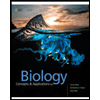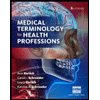
EBK HUMAN ANATOMY & PHYSIOLOGY
1st Edition
ISBN: 9780100659834
Author: AMERMAN
Publisher: YUZU
expand_more
expand_more
format_list_bulleted
Concept explainers
Textbook Question
Chapter 20, Problem 18CYR
Type I hypersensitivity is due to release of inflammatory mediators from _________, and type IV hypersensitivity is due to the actions of _________.
a.
b. neutrophils;
c. B cells;
d. mast cells;
Expert Solution & Answer
Want to see the full answer?
Check out a sample textbook solution
Students have asked these similar questions
What will control the rate of bioremediation of petroleum? (Choose all correct answers)
The availability of the petroleum
The temperature of the water
The availability of oxygen
The percent of the population that has degraded petroleum in the past
Which of the following would lead to a false negative result in a sandwich ELISA (the lab manual refers to this as a direct ELISA- also known as search for antigen)? Mark all correct answers.
antibody was non-specific and bound to something other than the antigen of interest.
too short of a duration when incubating the reagents in the plate.
If there are multiple strains of the pathogen of interest and the antibody does not recognize one of the strains.
Did not sample the correct bodily fluid/area to detect the antigen
concentration of antigen was too low to detect in the patient sample.
inadequate washing was performed after the enzyme linked antibody was allowed to bind.
substrate was exposed to too much light
reusing a pipette that was used to pipette a positive sample.
S.
+1269 pts
/1500
© Macmillan Learning
0
Resources
Solution
Penalized
Feedback
Try Again
Draw the final product with stereochemistry and lone pairs. The leaving group has been pre-drawn for
your convenience.
+100
+100
: 0:
+
H,C-
:0:
: 0
0 :
+100
+94
possible
✓ +100
K
Attemp
Chapter 20 Solutions
EBK HUMAN ANATOMY & PHYSIOLOGY
Ch. 20.1 - What are the main functions of the lymphatic...Ch. 20.1 - 2. How do lymphatic capillaries differ from blood...Ch. 20.1 - What is the pathway of lymph flow from the right...Ch. 20.1 - 4. What main cell types are located in lymphoid...Ch. 20.1 - List the main functions of MALT, lymph nodes, the...Ch. 20.2 - 1. How do innate immunity and adaptive immunity...Ch. 20.2 - 2. What are the three lines of defense?
Ch. 20.2 - What are the bodys main surface barriers, and how...Ch. 20.2 - Prob. 4QCCh. 20.2 - How are the immune system and lymphatic system...
Ch. 20.3 - Match the following cell types with their correct...Ch. 20.3 - Which of the cells in question 1 do not directly...Ch. 20.3 - What is the complement system, and what are its...Ch. 20.3 - In what two ways is the complement system...Ch. 20.3 - 5. What are the main cytokines of innate...Ch. 20.3 - What are the four cardinal signs of inflammation?Ch. 20.3 - 7. What are inflammatory mediators, and what do...Ch. 20.3 - Explain the role of phagocytes in the inflammatory...Ch. 20.3 - What causes the elevated temperature and common...Ch. 20.3 - Prob. 10QCCh. 20.4 - 1. What are MHC molecules?
Ch. 20.4 - 2. How do class I and class II MHC molecules...Ch. 20.4 - How are T cells activated?Ch. 20.4 - Prob. 4QCCh. 20.4 - What are the main functions of TC cells?Ch. 20.4 - Prob. 6QCCh. 20.4 - Prob. 7QCCh. 20.5 - 1. How is a B cell activated?
Ch. 20.5 - Prob. 2QCCh. 20.5 - What are the five classes of antibody, and how do...Ch. 20.5 - 4. List the five main functions of antibodies.
Ch. 20.5 - How do the primary and secondary immune responses...Ch. 20.5 - 6. What is the purpose of a vaccination, and what...Ch. 20.5 - 7. How do active immunity and passive immunity...Ch. 20.6 - How do innate immunity and adaptive immunity work...Ch. 20.6 - Walk through the basic steps of the immune...Ch. 20.6 - How does the immune system survey the body for...Ch. 20.6 - Walk through the steps of the immune response to...Ch. 20.6 - Prob. 5QCCh. 20.6 - 6. How do cancer cells escape the immune response...Ch. 20.7 - Define the four types of hypersensitivity...Ch. 20.7 - Explain how type IV hypersensitivity differs from...Ch. 20.7 - How do primary and secondary immunodeficiency...Ch. 20.7 - Prob. 4QCCh. 20.7 - What is an autoimmune disorder? What produces the...Ch. 20.7 - 6. What are the potential causes of autoimmune...Ch. 20 - 1. Which of the following is not a function of the...Ch. 20 - Mark the following statements as true or false. If...Ch. 20 - Fill in the blanks: The lymphoid organ that...Ch. 20 - Fill in the blanks: Nonspecific immunity is also...Ch. 20 -
5. Which of the following make up the body’s...Ch. 20 - Which of the following does not describe the...Ch. 20 - Mark the following statements as true or false. If...Ch. 20 - Which of the following functions is/are performed...Ch. 20 - Prob. 9CYRCh. 20 - 10. When naïve B cells are activated, they...Ch. 20 - 11. Match the following antibodies with the...Ch. 20 - Mark the following statements as true or false. If...Ch. 20 - Prob. 13CYRCh. 20 - On which type(s) of cells are class I MHC...Ch. 20 - Fill in the blanks: Class I MHC molecules display...Ch. 20 - 16. Which of the following is not a role of TH...Ch. 20 - 17. Mark the following statements as true or...Ch. 20 - 18. Type I hypersensitivity is due to release of...Ch. 20 - Prob. 19CYRCh. 20 - Prob. 20CYRCh. 20 - Prob. 1CYUCh. 20 - Complement proteins are crucial for stimulating...Ch. 20 - 3. Terrence has severe asthma and allergies, and...Ch. 20 - Your friend tests her snake-wrangling skills on an...Ch. 20 - 2. Carla presents to her physician with a...Ch. 20 - 3. Mr. White has been diagnosed with febrile...Ch. 20 - Mr. White developed neutropenia as a consequence...Ch. 20 - 5. The chemotherapeutic drugs Mr. White is taking...
Knowledge Booster
Learn more about
Need a deep-dive on the concept behind this application? Look no further. Learn more about this topic, biology and related others by exploring similar questions and additional content below.Similar questions
- +1269 pts /1500 © Macmillan Learning t/1188d950-dd73-11e0-9572-0800200c9a66/3045511b-267e-4a00-86ca-85dbc62ecb4e/6ac3a0c9-... a □ 出 All Bookmarks Due: Mon, May 26 Resources Solution Penalized Feedback Try Again KX Attempt 3 Draw the final product with stereochemistry and lone pairs. The leaving group has been pre-drawn for your convenience. :0: + нс H,C- :0: : 0:arrow_forwards. +1169 pts /1500 © Macmillan Learning 0 Resources Hint Submit Answer Step 3: This tertiary carbocation intermediate readily undergoes elimination with any weak base to form two possible products. + + H :0: H +94 possible 3a) Draw the minor organic product of elimination. Select Draw Templates More +100 +95 possible # C Major product + Minor product 3b) Draw the major organic product of elimination. Erase Select Draw Templates More C Erasearrow_forwardExplain the Science & Society on (with links and pictures): ---- Question down below Discuss the ethical, medical, and societal implications of using advanced genetic techniques?arrow_forward
- Explain the Disease Mechanism & Impact on (with links and pictures): What causes Leigh Syndrome and why it's so deadly. Which cellular functions, organelles (especially mitochondria), and macromolecules are involved.arrow_forwardExplain the Disease Mechanism & Impact on (with links and pictures): What's going wrong inside the cell and the effects on the human body. Describe metabolism with an emphasis on cellular respiration.arrow_forwardExplain the Disease Mechanism & Impact on (with links and pictures):arrow_forward
- Explain the Science & Society on (with links and pictures): Discuss the ethical, medical, and societal implications of using advanced genetic techniques.arrow_forward↑ LED Tt O Tt e 0 ✓ B > FLORES DIology Second Semester Review 7. Chi Square Analysis: wild dumpy male x ebony wild female F1: All wild wild F2: 142 wild wild males 52 wild ebony males 46 dumpy wild males 17 dumpy ebony males 151 wild wild females 47 wild ebony females 51 dumpy wild females 8 dumpy ebony females What pattern of inheritance is observed for body color? Autosomal recessive Autosomal dominant Sex-linked recessive Sex-linked dominant What are the genotypes of the parents in the P generation? a. XBYdd x XbXbDD b. Bbdd x bbDd c. BBdd x bbDD d. BBX Y x bbXDY How many flies in the F2 generation would you expect to express the dumpy wild phenotype? a. 289.125 b. 97 c. 96.375 d. 293arrow_forward4. This question focuses on entrainment. a. What is entrainment? b. What environmental cues are involved in entrainment, and which one is most influential? c. Why is entrainment necessary? d. Assuming that a flash of darkness is an effective zeitgeber, what impact on circadian rhythms would you expect to result from an event such as the 2024 solar eclipse (assume it was viewed from Carbondale IL, where totality occurred at about 2 pm)? Explain your reasoning. You may wish to consult this phase response diagram. Phase Shift (Hours) Delay Zone Advance Zone Dawn Mid-day Dusk Night Dawn Time of Light Stimulus e. Finally, give a real-world example of how knowledge of circadian rhythms and entrainment has implications for human health and wellbeing or conservation biology. This example could be from your reading or from things discussed in class.arrow_forward
- Generate one question that requires a Punnet Squre to solve the question. Then show how you calculate the possibilities of genotype and phenotypearrow_forwardBriefly state the physical meaning of the electrocapillary equation (Lippman equation).arrow_forwardExplain in a small summary how: What genetic information can be obtained from a Punnet square? What genetic information cannot be determined from a Punnet square? Why might a Punnet Square be beneficial to understanding genetics/inheritance?arrow_forward
arrow_back_ios
SEE MORE QUESTIONS
arrow_forward_ios
Recommended textbooks for you

 Medical Terminology for Health Professions, Spira...Health & NutritionISBN:9781305634350Author:Ann Ehrlich, Carol L. Schroeder, Laura Ehrlich, Katrina A. SchroederPublisher:Cengage Learning
Medical Terminology for Health Professions, Spira...Health & NutritionISBN:9781305634350Author:Ann Ehrlich, Carol L. Schroeder, Laura Ehrlich, Katrina A. SchroederPublisher:Cengage Learning- Essentials of Pharmacology for Health ProfessionsNursingISBN:9781305441620Author:WOODROWPublisher:Cengage



Medical Terminology for Health Professions, Spira...
Health & Nutrition
ISBN:9781305634350
Author:Ann Ehrlich, Carol L. Schroeder, Laura Ehrlich, Katrina A. Schroeder
Publisher:Cengage Learning



Essentials of Pharmacology for Health Professions
Nursing
ISBN:9781305441620
Author:WOODROW
Publisher:Cengage
Immune System and Immune Response Animation; Author: Medical Sciences Animations;https://www.youtube.com/watch?v=JDdbUBXPKc4;License: Standard YouTube License, CC-BY
Immune response: summary; Author: Dr Bhavsar Biology;https://www.youtube.com/watch?v=ADANgHkX4OY;License: Standard Youtube License